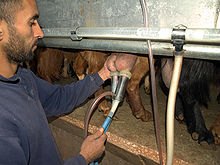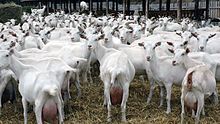Goat milk



Goat milk is the milk of domestic goats.
Goats produce about 2% of the world's total annual milk supply.[1] Some goats are bred specifically for milk.
Goat milk naturally has small, well-emulsified fat globules, which means the cream will stay in suspension for a longer period of time than cows milk; therefore, it does not need to be homogenized. Eventually, the cream will rise to the top over a period of a few days. Indeed, if the milk is to be used to make cheese, homogenization is not recommended, as this changes the structure of the milk, affecting the culture's ability to coagulate the milk and the final quality and yield of cheese.[2]
Dairy goats in their prime (generally around the third or fourth lactation cycle) average—2.7 to 3.6 kg (6 to 8 lb)—of milk production daily—roughly 2.8 to 3.8 l (3 to 4 U.S. qt)—during a ten-month lactation, producing more just after freshening and gradually dropping in production toward the end of their lactation. The milk generally averages 3.5% butterfat.[3]
Сheese[]

Goat milk is commonly processed into cheese, butter, ice cream, yogurt, cajeta and other products.
Goat cheese is known as fromage de chèvre ("goat cheese") in France. Some varieties include Rocamadour and Montrachet.[4] Goat butter is white because goats produce milk with the yellow beta-carotene converted to a colorless form of vitamin A. Goat milk has less cholesterol [5]
Nutrition[]
The American Academy of Pediatrics discourages feeding infants milk derived from goats. An April 2010 case report[6] summarizes their recommendation and presents "a comprehensive review of the consequences associated with this dangerous practice", also stating, "Many infants are exclusively fed unmodified goat's milk as a result of cultural beliefs as well as exposure to false online information. Anecdotal reports have described a host of morbidities associated with that practice, including severe electrolyte abnormalities, metabolic acidosis, megaloblastic anemia, allergic reactions including life-threatening anaphylactic shock, hemolytic uremic syndrome, and infections." Untreated caprine brucellosis results in a 2% case fatality rate. According to the USDA, doe milk is not recommended for human infants because it contains "inadequate quantities of iron, folate, vitamins C and D, thiamine, niacin, vitamin B6, and pantothenic acid to meet an infant’s nutritional needs" and may cause harm to an infant's kidneys and could cause metabolic damage.[7]
The department of health in the United Kingdom has repeatedly released statements stating on various occasions that[8] "Goats' milk is not suitable for babies, and infant formulas and follow-on formulas based on goats' milk protein have not been approved for use in Europe", and "infant milks based on goats' milk protein are not suitable as a source of nutrition for infants."[9] Moreover, according to the Canadian federal health department Health Canada, most of the dangers of, and counter-indications for, feeding unmodified goat's milk to infants parallel those associated with unmodified cow's milk — especially insofar as allergic reactions go.[10]
However, some farming groups promote the practice. For example, Small Farm Today, in 2005, claimed beneficial use in invalid and convalescent diets, proposing that glycerol ethers, possibly important in nutrition for nursing infants, are much higher in does' milk than in cows' milk.[11] A 1970 book on animal breeding claimed that does' milk differs from cows' or humans' milk by having higher digestibility, distinct alkalinity, higher buffering capacity, and certain therapeutic values in human medicine and nutrition.[12] George Mateljan suggested doe milk can replace ewe milk or cow milk in diets of those who are allergic to certain mammals' milk.[13] However, like cow milk, doe milk has lactose (sugar), and may cause gastrointestinal problems for individuals with lactose intolerance.[13] In fact, the level of lactose is similar to that of cow milk.[9]
Some researchers and companies producing goat's milk products have made claims that goat's milk is better for human health than most Western cow's milk due to it mostly lacking a form of β-casein proteins called A1, and instead mostly containing the A2 form, which does not metabolize to β-casomorphin 7 in the body.[14][15][16][17]
Like whole cow's milk, goat's milk is not recommended for use by infants due to the discrepancy between the composition of goat's milk and female and the imperfection of the child's digestive organs for digesting evolutionarily unsuitable food. Lack of folic acid when using goat's milk instead of breastfeeding in children leads to the development of B12 folate deficiency anemia. In the event of an allergic reaction in children to cow's milk, contrary to popular belief, the likelihood of developing it to goat's milk is equally high.[18]
| Constituent | Doe (goat) | Cow | Human |
|---|---|---|---|
| Fat (g) | 3.8 | 3.6 | 4.0 |
| Protein (g) | 3.5 | 3.3 | 1.2 |
| Lactose (g) | 4.1 | 4.6 | 6.9 |
| Ash (g) | 0.8 | 0.7 | 0.2 |
| Total solids (g) | 12.2 | 12.3 | 12.3 |
| Calories | 70 | 69 | 68 |
| Constituents | unit | Cow | Doe (goat) |
Ewe (sheep) |
Water buffalo |
|---|---|---|---|---|---|
| Water | g | 87.8 | 88.9 | 83.0 | 81.1 |
| Protein | g | 3.2 | 3.1 | 5.4 | 4.5 |
| Fat | g | 3.9 | 3.5 | 6.0 | 8.0 |
| Carbohydrates | g | 4.8 | 4.4 | 5.1 | 4.9 |
| Energy | kcal | 66 | 60 | 95 | 110 |
| Energy | kJ | 275 | 253 | 396 | 463 |
| Sugars (lactose) | g | 4.8 | 4.4 | 5.1 | 4.9 |
| Cholesterol | mg | 14 | 10 | 11 | 8 |
| Calcium | IU | 120 | 100 | 170 | 195 |
| Saturated fatty acids | g | 2.4 | 2.3 | 3.8 | 4.2 |
| Monounsaturated fatty acids | g | 1.1 | 0.8 | 1.5 | 1.7 |
| Polyunsaturated fatty acids | g | 0.1 | 0.1 | 0.3 | 0.2 |
These compositions vary by breed (especially in the Nigerian Dwarf breed), animal, and point in the lactation period.
References[]
- ^ FAO. 1997. 1996 Production Yearbook. Food Agr. Organ., UN. Rome, Italy.
- ^ Amrein-Boyes, D. (2009). 200 Easy Homemade Cheese Recipes. Robert Rose Inc.: Toronto
- ^ American Dairy Goat Association, adga.org
- ^ Chèvre cheese Archived 2009-01-10 at the Wayback Machine, foodnetwork.com
- ^ "Goat's Milk in Nagercoil". amd integrated farms.
- ^ Basnet, S.; Schneider, M.; Gazit, A.; Mander, G.; Doctor, A. (2010). "Fresh Goat's Milk for Infants: Myths and Realities—A Review". Pediatrics. 125 (4): e973–e977. doi:10.1542/peds.2009-1906. PMID 20231186. Retrieved 14 July 2010.
- ^ "Infant Formula Feeding" (PDF). USDA. Retrieved 17 June 2010.
- ^ Edwardes, Charlotte (2005-06-19). "Fresh Goat's Milk for Infants: Myths and Realities—A Review". Daily Telegraph. London. Retrieved 14 July 2010.
- ^ Jump up to: a b Professor Martin Marshall – Deputy Chief Medical Officer – Department of Health (22 August 2006). "Withdrawal From Sale of Infants Milks Based on Goats' Milk on 17 September 2006". non-urgent memo. Department of Health. Archived from the original on 29 August 2006. Retrieved 2007-08-12.
- ^ [1] Archived August 19, 2012, at the Wayback Machine
- ^ Small farm today. 22–24. Missouri Farm Pub. 2005. ISBN 978-1-58017-161-8.
- ^ Devendra, C., and M. Burns. 1970. Goat production in the tropics. Commonwealth Bur. Anim. Breeding and Genetics, Tech. Commun. No. 19.
- ^ Jump up to: a b The World's Healthiest Foods. "Milk, goat" Archived 2008-05-03 at the Wayback Machine, whfoods.org
- ^ Woodford, Keith (2010). Devil in the milk - Illness, health and politics A1 and A2 milk (Updated ed.). Craig Potton Publishing. p. 21. ISBN 978-1-877333-70-5.
- ^ Jung, Tae-Hwan; Hwang, Hyo-Jeong; Yun, Sung-Seob; Lee, Won-Jae; Kim, Jin-Wook; Ahn, Ji-Yun; Jeon, Woo-Min; Han, Kyoung-Sik (2017-12-31). "Hypoallergenic and Physicochemical Properties of the A2 β-Casein Fractionof Goat Milk". Korean Journal for Food Science of Animal Resources. 37 (6): 940–947. doi:10.5851/kosfa.2017.37.6.940. ISSN 1225-8563. PMC 5932946. PMID 29725217.
- ^ Pasin, Ph.D., Gonca (2017-02-09). "A2 Milk Facts - California Dairy Research Foundation". cdrf.org. Retrieved 2019-06-12.
- ^ "Why the A2 Protein Makes Goat Milk Such a Game Changer". The Good Goat Milk Company. 2017-08-15. Retrieved 2019-06-12.
- ^ Анемия // , 3-е изд. — М.: Советская энциклопедия. — Т. 1.
- ^ Park, W.Y., G.F.W. Haenlein.ed. 2006. Handbook of Milk of Non-Bovine Mammals. Blackwell Publishing.
- ^ "Milk analysis". North Wales Buffalo. Archived from the original on 2007-09-29. Retrieved 3 August 2009. (Citing McCane, Widdowson, Scherz, Kloos, International Laboratory Services.)
- Milk by animal
- Goats

